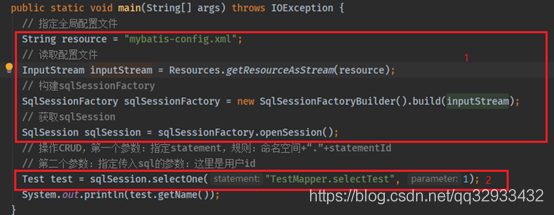詳解Mybatis是如何解析配置文件的
經(jīng)過前面三章的入門,我們大概了解了Mybatis的主線邏輯是什么樣子的,在本章中,我們將正式進入Mybatis的源碼海洋。
Mybatis是如何解析xml的構(gòu)建Configuration
我們調(diào)用new SqlSessionFactoryBuilder().build()方法的最終目的就是構(gòu)建 Configuration對象,那么Configuration何許人也?Configuration對象是一個配置管家, Configuration對象之中維護著所有的配置信息。Configuration的代碼片段如下
public class Configuration { //環(huán)境 protected Environment environment; protected boolean safeRowBoundsEnabled; protected boolean safeResultHandlerEnabled = true; protected boolean mapUnderscoreToCamelCase; protected boolean aggressiveLazyLoading; protected boolean multipleResultSetsEnabled = true; protected boolean useGeneratedKeys; protected boolean useColumnLabel = true; protected boolean cacheEnabled = true; protected boolean callSettersOnNulls; protected boolean useActualParamName = true; protected boolean returnInstanceForEmptyRow; //日志信息的前綴 protected String logPrefix; //日志接口 protected Class<? extends Log> logImpl; //文件系統(tǒng)接口 protected Class<? extends VFS> vfsImpl; //本地Session范圍 protected LocalCacheScope localCacheScope = LocalCacheScope.SESSION; //數(shù)據(jù)庫類型 protected JdbcType jdbcTypeForNull = JdbcType.OTHER; //延遲加載的方法 protected Set<String> lazyLoadTriggerMethods = new HashSet<String>( Arrays.asList(new String[] { 'equals', 'clone', 'hashCode', 'toString' })); //默認執(zhí)行語句超時 protected Integer defaultStatementTimeout; //默認的執(zhí)行器 protected ExecutorType defaultExecutorType = ExecutorType.SIMPLE; //數(shù)據(jù)庫ID protected String databaseId; //mapper注冊表 protected final MapperRegistry mapperRegistry = new MapperRegistry(this); //攔截器鏈 protected final InterceptorChain interceptorChain = new InterceptorChain(); //類型處理器 protected final TypeHandlerRegistry typeHandlerRegistry = new TypeHandlerRegistry(); //類型別名 protected final TypeAliasRegistry typeAliasRegistry = new TypeAliasRegistry(); //語言驅(qū)動 protected final LanguageDriverRegistry languageRegistry = new LanguageDriverRegistry(); //mapper_id 和 mapper文件的映射 protected final Map<String, MappedStatement> mappedStatements = new StrictMap<MappedStatement>( 'Mapped Statements collection'); //mapper_id和緩存的映射 protected final Map<String, Cache> caches = new StrictMap<Cache>('Caches collection'); //mapper_id和返回值的映射 protected final Map<String, ResultMap> resultMaps = new StrictMap<ResultMap>('Result Maps collection'); //mapper_id和參數(shù)的映射 protected final Map<String, ParameterMap> parameterMaps = new StrictMap<ParameterMap>('Parameter Maps collection'); //資源列表 protected final Set<String> loadedResources = new HashSet<String>(); 未完.......}構(gòu)建MappedStatement
在Configuration中,有個mappedStatements的屬性,這是個MappedStatement對象Map的集合,其key是這個mapper的namespace+對應(yīng)節(jié)點的id,而value是一個MappedStatement對象。在構(gòu)建Configuration的時候,會去解析我們的配置文件。解析配置文件的關(guān)鍵代碼如下
private void parseConfiguration(XNode root) { try { //issue #117 read properties first propertiesElement(root.evalNode('properties')); Properties settings = settingsAsProperties(root.evalNode('settings')); loadCustomVfs(settings); loadCustomLogImpl(settings); typeAliasesElement(root.evalNode('typeAliases')); pluginElement(root.evalNode('plugins')); objectFactoryElement(root.evalNode('objectFactory')); objectWrapperFactoryElement(root.evalNode('objectWrapperFactory')); reflectorFactoryElement(root.evalNode('reflectorFactory')); settingsElement(settings); // read it after objectFactory and objectWrapperFactory issue #631 environmentsElement(root.evalNode('environments')); databaseIdProviderElement(root.evalNode('databaseIdProvider')); typeHandlerElement(root.evalNode('typeHandlers')); mapperElement(root.evalNode('mappers')); } catch (Exception e) { throw new BuilderException('Error parsing SQL Mapper Configuration. Cause: ' + e, e); }}
上訴代碼段倒數(shù)第三行mapperElement(root.evalNode('mappers'));就是解析mappers處就是把我們的mapper文件封裝成MappedStatement對象,然后保存到Configuration的mappedStatements屬性中,其中key是這個mapper的namespace+對應(yīng)節(jié)點的id,而value是一個MappedStatement對象。保存的地方關(guān)鍵代碼如下
configuration.addMappedStatement(statement);
addMappedStatement()方法代碼如下
protected final Map<String, MappedStatement> mappedStatements = new StrictMap<MappedStatement>( 'Mapped Statements collection');public void addMappedStatement(MappedStatement ms) {mappedStatements.put(ms.getId(), ms);}
那么這個MappedStatement的又是何許人也?我們可以簡單的把MapperStatement理解為對sql的一個封裝,在MappedStatement中保存著一個SqlSource對象,其中就存有SQL的信息。相關(guān)代碼如下
public final class MappedStatement {private SqlSource sqlSource;}
SqlSource 代碼如下
public interface SqlSource { BoundSql getBoundSql(Object parameterObject);}
BoundSql代碼如下
public class BoundSql { private final String sql; private final List<ParameterMapping> parameterMappings;}
關(guān)于二級緩存我們在Configuration中看到了一個caches屬性
protected final Map<String, Cache> caches = new StrictMap<>('Caches collection');
這個東西的作用是什么呢?其實是關(guān)于Mybatis的二級緩存的。在解析配置文件的過程中,如果用到了二級緩存,便會把這個ID和對象也保存到configuration的caches中,相關(guān)代碼如下
public void addCache(Cache cache) { caches.put(cache.getId(), cache);}構(gòu)建SqlSessionFactory
在Configuration對象構(gòu)建完畢之后,就該依賴Configuration對象去構(gòu)建SqlSessionFactory對象了,相關(guān)代碼如下
public SqlSessionFactory build(Configuration config) { return new DefaultSqlSessionFactory(config);}
我們暫且把SqlSessionFactory稱為SqlSession工廠吧,SqlSessionFactory中有兩個方法,openSession()和getConfiguration()SqlSessionFactory代碼如下
public interface SqlSessionFactory { SqlSession openSession(); //其余openSession重載方法略… Configuration getConfiguration();}構(gòu)建SqlSession
openSession()方法會返回一個SqlSession對象,SqlSession又是何許人也?SqlSession可以理解為程序與數(shù)據(jù)庫打交道的一個工具,通過它,程序可以往數(shù)據(jù)庫發(fā)送SQL執(zhí)行。SqlSession代碼如下
public interface SqlSession extends Closeable { <T> T selectOne(String statement); <T> T selectOne(String statement, Object parameter); <E> List<E> selectList(String statement); <E> List<E> selectList(String statement, Object parameter); //其余增刪查改方法略…}總結(jié)
想必你已經(jīng)明白了,Mybatis解析xml最主要的目的其實是構(gòu)建Configuration對象,這個對象中可以說包含著Mybatis的所有配置信息。其中有一個mappedStatements屬性,這是一個Map,其中key是這個mapper的namespace+對應(yīng)節(jié)點的id,而value是一個MappedStatement對象,而MappedStatement中保存著一個SqlSource對象,這個對象中保存著我們要執(zhí)行的SQL語句。
那么在下一章,我們將一起探究Mybatis是如何執(zhí)行我們的SQL語句的。
到此這篇關(guān)于詳解Mybatis是如何解析配置文件的的文章就介紹到這了,更多相關(guān)Mybatis 解析配置文件內(nèi)容請搜索好吧啦網(wǎng)以前的文章或繼續(xù)瀏覽下面的相關(guān)文章希望大家以后多多支持好吧啦網(wǎng)!
相關(guān)文章:
1. SQLite教程(六):表達式詳解2. Mysql入門系列:建立MYSQL客戶機程序的一般過程3. 導出錯誤編碼的mysql數(shù)據(jù)庫4. SQLite3 API 編程手冊5. 在Oracle數(shù)據(jù)庫中移動數(shù)據(jù)文件的具體方法6. SQL語句中的ON DUPLICATE KEY UPDATE使用7. 使用 UIMA 和 DB2 Intelligent Miner 進行文本挖掘8. DB2數(shù)據(jù)庫的隔離級解讀與試驗9. Mysql入門系列:對MYSQL查詢中有疑問的數(shù)據(jù)進行編碼10. mysql啟動時報錯 ERROR! Manager of pid-file quit without

 網(wǎng)公網(wǎng)安備
網(wǎng)公網(wǎng)安備